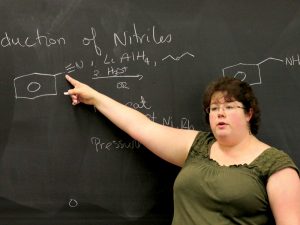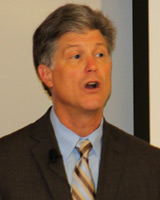 Chalk dust coats the fingers of assistant professor of chemistry Stephanie Gould from the many examples and problems written on the blackboard at the start of class.As she walks the room, helping students who look lost, she unconsciously rubs her hands on her slacks, leaving ghosting trails of dust where a pocket should be. Stephanie doesn’t notice; she’s keeping an eye on her 25 students, all engrossed in solving the day’s chemistry problems.
Chalk dust coats the fingers of assistant professor of chemistry Stephanie Gould from the many examples and problems written on the blackboard at the start of class.As she walks the room, helping students who look lost, she unconsciously rubs her hands on her slacks, leaving ghosting trails of dust where a pocket should be. Stephanie doesn’t notice; she’s keeping an eye on her 25 students, all engrossed in solving the day’s chemistry problems.
As she hands back a previous week’s tests, she stops to ask one student if something is wrong and to offer additional help. Her course, Organic Chemistry, is inherently challenging, and Stephanie holds her students to high standards. “I want everyone to succeed, but it’s a tough class,” Stephanie said. “It’s about putting in the work and learning how to work for yourself.”
Her students know her expectations. “She’s really fun and enthusiastic,” Caroline Her ’13 said. “She does a great job explaining mechanisms. She’s very approachable, which is helpful when you have questions and will slow down, even if it means being behind for the day.”
Stephanie’s class is more informal than a visitor might expect. She encourages students to work together to solve the problems on the board at the beginning of class. But she is completely in charge; when she speaks, the class falls silent, scribbling notes and drawing the chemical compositions in the examples. Stephanie says her method is straightforward: “I try to meet students where they are; if I have a class where I feel they are better at working problems, I try to lecture less.”’
A graduate of Rose-Hulman Institute of Technology in Terre Haute, Indiana, Stephanie’s personal experiences drove her career. “I went to a small school that had a similar relationship between faculty and students. I believe my learning experience was better for having that direct contact with faculty,” she said. “I always knew I wanted to teach somewhere that I could have that same impact on students.”
After completing her master’s degree and Ph.D. in organic chemistry at Arizona State University, Stephanie made her way to Austin College. “Working at a small school like Austin College allows me to be more connected with my students’ progress. If I see the same three questions being asked during office hours, I know they missed something in class, and it is time to circle back to reinforce that material,” she said.
She simultaneously holds her students responsible for what they should have already learned—reminding them to spend an hour every day working practice problems—and offering support to those who are falling behind.“I will make every attempt to help students learn, if they agree to do their part and try,” she said. “That means being available to help, even if it’s not during office hours. Usually, I can help provide that one little piece of information that helps the student put the puzzle together. I would prefer to help when there is a problem instead of having them wait a week to come to office hours.”
Stephanie manages a complex balancing act, with time for courses; answering student questions in person, over the phone, or via email; guiding student-researchers working on a project funded by the American Chemical Society; and personal time for her family. But her intense schedule seems to energize her; by the end of class, she often has the glow of a runner’s high for a class well-taught.
A $50,000 American Chemical Society grant funds Stephanie’s research on solid-state nanogears for molecular-scale machines. She is providing opportunities for students to work directly in the lab with her, researching ideas that may result in publications and professional experience for the students. The crystal-based gears could have uses including nanobots to deliver a cancer drug directly to malignant cells, protecting healthy cells from damage.

